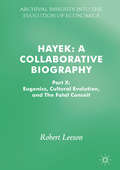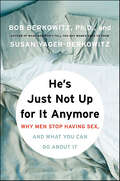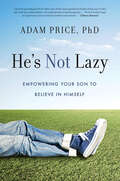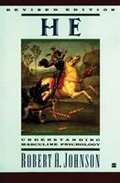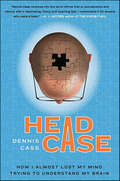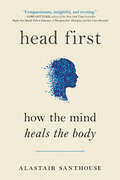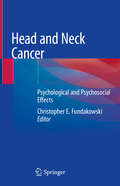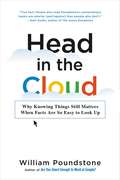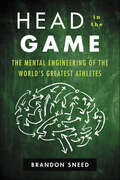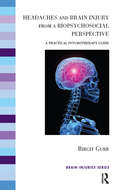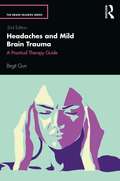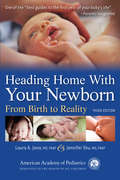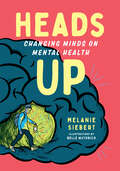- Table View
- List View
Hayek: Part X: Eugenics, Cultural Evolution, and The Fatal Conceit (Archival Insights into the Evolution of Economics)
by Robert LeesonThis tenth part of Robert Leeson's collaborative biography of Friedrich August von Hayek explores Hayek’s thought on the free market and democracy. Using an unparalleled array of archival materials, Leeson reconstructs Hayek’s thinking as the notorious economist and his acolytes set about reshaping the post-war economic order. Darker areas of Hayek’s thought are also explored, including the influence of eugenics on his thought and his support for radical right-wing dictatorships in South America. <P><P> Leeson concludes this volume with a collection of chapters written by eminent scholars of Hayek. These chapters cover subjects as diverse as Hayek’s influence on scholars of Darwinian evolution, his views on psychology, and cultural evolution.
Haze
by Kathy HoopmannSeb is a loner. Brilliant with numbers but hopeless with people, he prefers the company of computers and his only friend, Guzzle. Things change for the better when he makes friends with Kristie, Madeline and Jen, and a new computer teacher - Miss Adonia - arrives. However, Seb is soon caught up in a web of computer fraud and lies and turns to Madeline's mysterious cyber friend for help. Weaving the facts of Asperger Syndrome into the story, this fast-paced book is acclaimed author Kathy Hoopmann's best novel yet and will be a riveting read for teenagers of all sorts and abilities.
He Gathers Your Tears Words of Comfort for a Widow's Heart
by Phylis MooreThis is an excellent book written through the grieving period of a widow. Phylis Moore intersperses daily journal reflections with Scripture to offer comfort for the hardship described.
He Wanted the Moon
by Eve Claxton Mimi BairdA mid-century doctor's raw, unvarnished account of his own descent into madness, and his daughter's attempt to piece his life back together and make sense of her own. Texas-born and Harvard-educated, Dr. Perry Baird was a rising medical star in the late 1920s and 1930s. Early in his career, ahead of his time, he grew fascinated with identifying the biochemical root of manic depression, just as he began to suffer from it himself. By the time the results of his groundbreaking experiments were published, Dr. Baird had been institutionalized multiple times, his medical license revoked, and his wife and daughters estranged. He later received a lobotomy and died from a consequent seizure, his research incomplete, his achievements unrecognized. Mimi Baird grew up never fully knowing this story, as her family went silent about the father who had been absent for most of her childhood. Decades later, a string of extraordinary coincidences led to the recovery of a manuscript which Dr. Baird had worked on throughout his brutal institutionalization, confinement, and escape. This remarkable document, reflecting periods of both manic exhilaration and clear-headed health, presents a startling portrait of a man who was a uniquely astute observer of his own condition, struggling with a disease for which there was no cure, racing against time to unlock the key to treatment before his illness became impossible to manage. Fifty years after being told her father would forever be "ill" and "away," Mimi Baird set off on a quest to piece together the memoir and the man. In time her fingers became stained with the lead of the pencil he had used to write his manuscript, as she devoted herself to understanding who he was, why he disappeared, and what legacy she had inherited. The result of his extraordinary record and her journey to bring his name to light is He Wanted the Moon, an unforgettable testament to the reaches of the mind and the redeeming power of a determined heart.
He's Gone...You're Back
by Kerika FieldsYour relationship may be over--but you've only just begun. . . It may have been a long time coming, but the moment in your relationship when you know it's over once and for all, has finally arrived. And while this signifies an ending, it also means a beautiful new beginning. In this supportive and inspiring book, Kerika Fields helps you navigate the dark, scary post-relationship abyss, and come out the other side ready to laugh--and love--again. With humor, understanding--and real-life stories from women just like you--Kerika shows you how to mourn the loss, and move on. Here is a mind, body, and spirit plan for recovery that will guide and reassure you through the worst days, and prepare you for the future--because the best really is yet to come. Discover how to: Commit to your recovery like you were committed to your relationship Avoid becoming another angry, bitter woman (there are enough of those!) Keep showing up to your life--no matter how disappointed or depressed you are Fight--and win--the toughest battle: between yourself and your demons Complete with a daily self-love checklist, affirmations, recommended reading, an uplifting You're Back! playlist to get you dancing through your tears, and much more. Whether you're stuck in the limbo of a painful relationship or struggling in solitude, this invaluable book will see you through to a life filled with abundance and joy.
He's Just Not Up for It Anymore: Why Men Stop Having Sex, and What You Can Do About It
by Susan Yager-Berkowitz Bob BerkowitzAn estimated twenty million American men and women are in relationships in which the man has stopped being sexually intimate. Is the problem physical, emotional, or psychological—or are these guys simply bored with their partners?To find answers, bestselling author and relationship expert Dr. Bob Berkowitz and his wife, Susan Yager-Berkowitz, began an unprecedented survey of more than four thousand men and women in this situation, gathering data and following up with hundreds of interviews with selected respondents. Why Men Stop Having Sex provides a unique window into the sexless man's mind—so that men and women can understand this important issue and begin to address the problems that have inhibited intimacy, and ultimately solve them.
He's Not Lazy: Empowering Your Son to Believe In Himself (He's Not Lazy)
by Adam Price&“Clinical psychologist Price offers one of the most significant books of the year in this new look at an old problem—the underperforming teenage boy… Price&’s book brings an important voice to a much needed conversation.&” —Library Journal (Starred review) On the surface, capable teenage boys may look lazy. But dig a little deeper, writes child psychologist Adam Price in He&’s Not Lazy, and you&’ll often find conflicted boys who want to do well in middle and high school but are afraid to fail, and so do not try. This book can help you become an ally with your son, as he discovers greater self-confidence and accepts responsibility for his future.Why are some teenage boys unmotivated? Why do they spend endless hours playing video games or glued to their phones and social media sites instead of studying? Is this a sign of laziness or something more troubling? As a clinical psychologist, Dr. Adam Price has found that teenage boys are extremely sensitive to the stress of our competitive achievement-oriented culture—one that has created a pressure cooker for today&’s adolescent. In He&’s Not Lazy, Dr. Price, a renowned expert on ADHD and learning disabilities, explains how to help a boy who is not lazy, but rather, is conflicted about trying his best. Dr. Price will guide you to discover hidden obstacles to your son&’s success, set expectations, and empower him to accept responsibility for his own future. He&’s Not Lazy will help you become your son&’s ally, as he discovers greater self-confidence and becomes more self-reliant. Rather than reacting to pressure by shunning academic responsibilities altogether or propping up fear-based rebellion with justifications like &“I am not going to be one of those nerds who have no life,&” or &“Tests don&’t measure intelligence or help you learn, so what&’s the point of studying for them?&” your teenage son can work with you using the guidance in this book.
He: Understanding Masculine Psychology
by Robert A. JohnsonWhat does it really mean to be a man? What are some of the landmarks along the road to mature masculinity? And what of the feminine components of a man's personality? <p><p> Women do not really know as much about men as they think they do. They have developed, over the centuries, considerable expertise in the technique of adapting to men, but that is not the same as truly understanding them. Women often labor under the delusion that life is really pretty easy for men, at least when compared to their own lot, and they have no idea what a complicated struggle is really involved in the transition from male childhood to real manhood. <p> As timely today as when it was first published, He provides a fascinating look into male identity and how female dynamics influence men.
He: Understanding Masculine Psychology
by Robert A. Johnson“Entertaining, informative, thought-provoking, mysterious, poetic. Men who read it will surely learn much about themselves, and women—particularly those who are unfortunately misled into thinking of men as “the enemy”—will find it a real eye-opener.”—Ruth Tiffany Barnhouse, M.D., Th.M., Harvard UniversityRobert A. Johnson's classic work exploring the differences between man and woman, female and male—newly reissued.What does it really mean to be a man? What are some of the landmarks along the road to mature masculinity? And what of the feminine components of a man's personality? Women do not really know as much about men as they think they do. They have developed, over the centuries, considerable expertise in the technique of adapting to men, but that is not the same as truly understanding them. Women often labor under the delusion that life is really pretty easy for men, at least when compared to their own lot, and they have no idea what a complicated struggle is really involved in the transition from male childhood to real manhood.As timely today as when it was first published, He provides a fascinating look into male identity and how female dynamics influence men.
Head Case: How I Almost Lost My Mind Trying to Understand My Brain
by Dennis Cass“Dennis Cass ventures into the terra infirma that is neuroscience, and returns with a fascinating, funny and touching tale. I recommend it for anyone who owns a brain.” -- AJ Jacobs, New York Times Bestselling author of The Know it AllIn the tradition of Supersize Me, Dennis Cass becomes a human guinea pig in a darkly comic journey to understand the human brain and find out what makes us who we areInfiltrating the world of neuroscience, Cass offers his own brain up to science, subjecting his mind and body to electric shocks, mind-numbing attention tests, stress tests of his own devising and cigarettes. In the spirit of George Plimpton and early Tom Wolfe, his exploits reveal the intricacies of fear, attention, stress, reward and consciousness from the inside out. Along the way, he weaves in the story of stepfather’s manic depression and drug addiction, as well as his own troubles with stress and depression, giving neuroscience a personal touch along with the clinical facts.Cass attacks the subject of the human brain with wit and candor, turning popular science into something distinctly human. Head Case is an imperative read for anyone who’s ever asked themselves why they are who they are.
Head Cases: Julia Kristeva on Philosophy and Art in Depressed Times (Columbia Themes in Philosophy, Social Criticism, and the Arts)
by Elaine MillerWhile philosophy and psychoanalysis privilege language and conceptual distinctions and mistrust the image, the philosopher and psychoanalyst Julia Kristeva recognizes the power of art and the imagination to unblock important sources of meaning. She also appreciates the process through which creative acts counteract and transform feelings of violence and depression. Reviewing Kristeva's corpus, Elaine P. Miller considers the intellectual's "aesthetic idea" and "thought specular" in their capacity to reshape depressive thought on both the individual and cultural level. She revisits Kristeva's reading of Walter Benjamin with reference to melancholic art and the imagination's allegorical structure; her analysis of Byzantine iconoclasm in relation to Freud's psychoanalytic theory of negation and Hegel's dialectical negativity; her understanding of Proust as an exemplary practitioner of sublimation; her rereading of Kant and Arendt in terms of art as an intentional lingering with foreignness; and her argument that forgiveness is both a philosophical and psychoanalytic method of transcending a "stuck" existence. Focusing on specific artworks that illustrate Kristeva's ideas, from ancient Greek tragedy to early photography, contemporary installation art, and film, Miller positions creative acts as a form of "spiritual inoculation" against the violence of our society and its discouragement of thought and reflection.
Head First: How The Mind Heals The Body
by Alastair SanthouseIn the tradition of Lori Gottlieb and Henry Marsh, a distinguished psychiatrist examines his own practice. Alastair Santhouse knew something was wrong the night he was on call during his medical training and got the news that a woman on the way to the ER had died in the ambulance. That meant he could go back to sleep! But he couldn't. He was overtaken with the sense that his joyful reaction was terrible failure. That night began his long journey away from the ER and into psychiatry. Head First chronicles Santhouse's many years treating patients and his exploration of the ways in which our minds exert a huge and underappreciated influence over our health. They shape our responses to symptoms that we develop, dictate the treatments we receive, and influence whether they work. They even influence whether we develop symptoms at all. Written with brutal honesty, deep compassion, and a wry sense of humor, Head First examines difficult cases that illuminate some of our most puzzling and controversial medical issues--from the tragedy of suicide, to the stigma surrounding obesity, to the mysteries of self-induced illness. Ultimately he finds that our medical model has failed us by promoting specialization and overlooking perhaps the single most important component of our health: our state of mind.
Head Over Heels: Wives Who Stay with Cross-Dressers and Transsexuals
by Virginia ErhardtCandid, first-hand accounts of couples who stay together despite highly emotional gender issues. Head Over Heels gives voice to thirty ordinary women who live extraordinary lives as partners to crossdressers, transgenderists, and male-to-female transsexuals. These unique women discuss, with honesty and great candor, how they first learned of their partners’ gender issues, how they’ve coped with the emotions that followed, how they’ve dealt with concerns about privacy/secrecy, and how they’ve handled disclosure to children, friends, and family members. Far from a collection of “happily ever after” stories, these narratives are filled with pain, courage, curiosity, and joy as each woman struggles to redefine a relationship that includes intimacy, social acceptance, dignity, and respect. The women whose stories are featured in Head Over Heels didn't know their partners were gender-variant when they first met. Some found out early on; others learned of their husbands' gender variance after decades of marriage. Some were told by their husbands—men they considered “regular guys;” others found out on their own, sometimes in shocking ways. Their stories represent a wide spectrum of women's life experiences with crossdressers, transgenderists, transsexuals who are nonoperative, pre-operative, and post-operative, families without children, families with children at home, and families with children who have left home. But these women share one thing in common: each has decided to stay in her relationship, exploring her new life with an open, yet cautious, heart. Some of the voices heard in Head Over Heels: “While putting my clothes on, I found a sales receipt on the bureau from K-Mart for shoes, a bra, and stockings. My immediate thought was that my husband had a girlfriend.” “He dressed for me one night and it was the worst experience of both our lives. I was shocked and he knew it and that hurt him.” “My siblings had been aware of Trish’s transsexualism for several years when she went full-time. They have told me that while I will always be welcome in their homes, Trish is not.” “My husband may think differently, but I do have a sexual identity. Actually, I’m real clear about it—I am a woman and he is a man. I do not allow him to crossdress in the bedroom. I married a man; therefore, I will sleep with a man.” Head Over Heels also includes historical and current information about resources and support for wives of gender-variant people, and a substantive introduction that includes basic information about sexual and gender identity and related issues.
Head and Neck Cancer: Psychological and Psychosocial Effects
by Christopher E. FundakowskiThis volume serves to help readers understand and address factors that contribute to the psychological distress and negative self-perception of patients with head and neck cancer to improve their quality of life. It explores many of these issues in depth, such as the trends in diagnosis of head and neck cancer, disfigurement, advances and outcomes associated with minimally invasive surgery, long-term quality of life and functional outcomes, issues related to cancer pain, importance and impact of nutrition, how reconstructive advances effect functional outcomes, the impact of cancer recurrence, and financial consequences of cancer diagnosis and treatment. Head and Neck Cancer: Psychological and Psychosocial Effects will help otolaryngologists, oncologists, surgeons, psychologists and healthcare professionals define the unique issues associated with the HNC patient population, discuss pertinent data, outline key aspects of high quality care in this population, and to draw attention to necessary future investigations and developments.
Head in the Cloud: Dispatches from a Post-Fact World
by William PoundstoneNever before have we had so much information at our fingertips. You might think that we are better-informed than ever, but there&’s one thing we can&’t ask Google: &‘What should I be googling?&’ The way we consume information in the digital age has been blamed for driving political polarisation and leaving us unable to agree on basic facts. It&’s also making us stupider. Personalised news feeds and social media echo chambers narrow our potential knowledge base. By now, we don&’t even know what we don&’t know. In Head in the Cloud, William Poundstone investigates the true worth of knowledge. An entertaining manifesto underpinned by big data analysis and illustrated by eye-opening anecdotes, it reveals the surprising benefits of broadening your horizons and provides an unnerving look at the consequences of being ill-informed.
Head in the Cloud: Why Knowing Things Still Matters When Facts Are So Easy to Look Up
by William PoundstoneThe real-world value of knowledge in the mobile-device age.More people know who Khloe Kardashian is than who Rene Descartes was. Most can't find Delaware on a map, correctly spell the word occurrence, or name the largest ocean on the planet. But how important is it to fill our heads with facts? A few keystrokes can summon almost any information in seconds. Why should we bother learning facts at all?Bestselling author William Poundstone confronts that timely question in HEAD IN THE CLOUD. He shows that many areas of knowledge correlate with the quality of our lives--wealth, health, and happiness--and even with politics and behavior. Combining Big Data survey techniques with eye-opening anecdotes, Poundstone examines what Americans know (and don't know) on topics ranging from quantum physics to pop culture. HEAD IN THE CLOUD asks why we're okay with spelling errors on menus but not on resumes; why Fox News viewers don't know which party controls Congress; why people who know "trivia" make more money than those who don't; how individuals can navigate clickbait and media spin to stay informed about what really matters. Hilarious, humbling, and wildly entertaining, HEAD IN THE CLOUD is a must-read for anyone who doesn't know everything.
Head in the Game: The Mental Engineering of the World's Greatest Athletes
by Brandon SneedAn intriguing blend of science and sports that explores how some of the worlds greatest athletes are utilizing the last frontier of performance-enhancing technology—the mental mapping and engineering of their own brains—for peak performance, and what it means for the future of athleticism, sports, and the rest of us.Moneyball showed how statistics were revolutionizing baseball. The Sports Gene revealed the role genetics play in sports. Now, Head in the Game examines the next evolution: how mental engineering—the manipulation of the cognitive processes of the brain—can make gifted athletes even better. For years, technology—from EEG (electroencephalogram) to fMRI (Functional magnetic resonance imaging) to video games, tablets, and personal data collection devices—have been used with soldiers to understand their physical and mental functioning. Touching on brain functionality vital to sports—both the "hard" (coordination, stimuli processing, functional memory, decision-making, load-processing) and the "soft" (emotion regulation, visualization, psychology, mindfulness)—this tech is now being adopted by scores of championship franchises and top athletes—including scrappy underdogs forced to innovate and elite players looking for an advantage. Star NFL quarterbacks Russell Wilson and Tom Brady, the NBA’s Kyle Korver, and Olympic volleyball champion Kerri Walsh are using mental engineering to up their game. It’s not luck that has transformed the San Antonio Spurs into a formidable force—it’s science, Sneed demonstrates. As mental engineering becomes widespread—taking athletes who are already freaks of nature and making them better—the impact on the multi-billion dollar sports industry will be dramatic on players, managers, trainers, owners, and even fans. Interviewing athletes and coaches, visiting training camps and sports science firms, Brandon Sneed offers a firsthand, on-the-ground look at this exciting breakthrough that has the potential to transform to transform the game—and all our lives.
Head, Heart, and Hands Listening in Coach Practice: The Listening Coach
by Kymberly Dakin-NealThis book is an exploration of intentional listening as an essential skill for coaches. It introduces the Head, Heart, and Hands Listening model as a vital tool to amplify effective listening in coaching practice. Accessible and applicable, the book explores the three listening modalities of Head, Heart, and Hands as active, though largely unconscious, lenses that inform the potency of our listening. Dakin-Neal argues that once coaches identify "how" they listen, they can assist their clients in more targeted ways to positively impact their personal and professional lives. Chapters are divided into the three listening modalities, Head, Heart, and Hands, and are filled with case studies, stories, reflective questions, and exercises from the author’s experience to help coaches strengthen their listening skills. The book also includes a comprehensive listening assessment for coaches to use in practice. This book is essential reading for coaches in practice and in training as well as organizational psychologists, HR professionals, and those working within corporations.
Head-Related Transfer Function and Acoustic Virtual Reality
by Kazuhiro IidaThis book covers all aspects of head-related transfer function (HRTF), from the fundamentals through to the latest applications, such as 3D sound systems. An introductory chapter defines HRTF, describes the coordinate system used in the book, and presents the most recent research achievements in the field. HRTF and sound localization in the horizontal and median planes are then explained, followed by discussion of individual differences in HRTF, solutions to this individuality (personalization of HRTF), and methods of sound image control for an arbitrary 3D direction, encompassing both classic theory and state of the art data. The relations between HRTF and sound image distance and between HRTF and speech intelligibility are fully explored, and measurement and signal processing methods for HRTF are examined in depth. Here, supplementary material is provided to enable readers to measure and analyze HRTF by themselves. In addition, some typical HRTF databases are compared. The final two chapters are devoted to the principles and applications of acoustic virtual reality. This clearly written book will be ideal for all who wish to learn about HRTF and how to use it in their research.
Headaches and Brain Injury from a Biopsychosocial Perspective: A Practical Psychotherapy Guide (The Brain Injuries Series)
by Birgit GurrPost-traumatic headache is the most common symptom after mild/moderate brain injury. Similar to the characteristics of naturally occurring headaches, it is multi-faceted in nature and includes neurophysiological, psychological and social aspects. Consequently, headache has an enormous impact on the quality of life of the sufferer. Effective headache treatment has a focus on all aspects of the pain and the needs of the individual. This book describes a cognitive-behavioural program which was developed as part of a research project in a brain injury service. It is based, firstly, on the evidence provided by the outcomes of this research project. The interested reader may study the literature associated with this research for which the references can be found at the back of this volume. Secondly, this headache therapy guide is the result of clinical experience and the application of cognitive behavioural therapy to patients who experience complex difficulties following a brain injury.
Headaches and Mild Brain Trauma: A Practical Therapy Guide (The Brain Injuries Series)
by Birgit GurrThis important book describes the biopsychosocial nature of persisting and complex headache presentations following a mild brain trauma and offers a predominantly cognitive behavioural therapy programme to guide patients toward better health and less pain. The book provides both a robust theoretical underpinning and practical therapeutic guidance for helping those who suffer from posttraumatic headaches. Placing physical symptoms of trauma in context with personal and social issues, it discusses the broader psychological implications at work after brain injury, including the idea that headaches play a functional role for the patient. Updated with the latest research findings, the book features clinical guidelines, practitioner worksheets and relaxation scripts, offering an all-inclusive manual for therapists setting up their own programmes. Written with the busy clinician in mind, it is essential reading for anyone working with brain trauma survivors.
Heading Home With Your Newborn
by Jennifer Shu Laura A. JanaThe new edition of this bestselling guide to newborn care has been fully revised and updated. Written by two pediatricians and focusing on the first few months of an infant’s life, Heading Home With Your Newborn, 3rd Edition, includes new information on breastfeeding and the involvement of allergies, formula options, vitamins and supplements (vitamins, iron, fluoride, probiotics), sleep, extended stay in strapped-in positions(car seats, bouncy chairs), swaddling, diaper options, the impact of social media sharing, and capturing moments/sharing memories.
Heads Up Psychology (DK Heads UP)
by Marcus WeeksMaking a difficult topic easier to comprehend, Heads Up Psychology offers big ideas, simply explained, for teen readers. Psychology is all around us — in the advertising we see, the politics we debate, and in the development of products we use every day. Using engaging graphics, Heads Up Psychology explores the big ideas from all areas of psychology including psychoanalysis, intelligence, and mental disorders. With easy-to-understand coverage of all the approaches to psychology, and the ideas of more than 60 psychologists, from Asch to Milgram and Ramachandran to Zimbardo, this introduction to an often complicated subject is written with young-adult readers in mind, and is structured around the questions they often ask, like "How do I fit in?", "Who needs parents, anyway?", and "Why do I feel so angry all the time?" In Heads Up Psychology, psychological theories are explained with the help of cleverly conceived graphic illustrations and diagrams to show how they relate to everyday life. Biography spreads give interesting insights into the lives and work of Freud, Pavlov, and more, while other psychologists and their big ideas are profiled in a comprehensive directory, and case study panels describe groundbreaking experiments in the field. Supports the Common Core State Standards.
Heads Up: Changing Minds on Mental Health (Orca Issues #4)
by Melanie Siebert★ “Informative, diverse, and highly engaging; a much-needed addition to the realm of mental health.”—Kirkus Reviews, starred review Featuring real-life stories of people who have found hope and meaning in the midst of life’s struggles, Heads Up: Changing Minds on Mental Health is the go-to guide for teenagers who want to know about mental health, mental illness, trauma and recovery. For too long, mental health problems have been kept in the shadows, leaving people to suffer in silence, or worse, to be feared, bullied or pushed to the margins of society where survival is difficult. This book shines a light on the troubled history of thinking about and treating mental illness and tells the stories of courageous pioneers in the field of psychiatry who fought for more compassionate, respectful and effective treatments. It provides a helpful guide to the major mental health diagnoses along with ideas and resources to support those who are suffering. But it also moves beyond a biomedical focus and considers the latest science that shows how trauma and social inequality impact mental health. The book explores how mental health is more than just “in our heads” and includes the voices of Indigenous people who share a more holistic way of thinking about wellness, balancing mind, body, heart and spirit. Highlighting innovative approaches such as trauma-informed activities like yoga and hip-hop, police mental health teams, and peer support for youth, Heads Up shares the stories of people who are sparking change.
Headscarves and Hymens: Why the Middle East Needs a Sexual Revolution
by Mona Eltahawy<p>The journalist Mona Eltahawy is no stranger to controversy. Through her articles and actions she has fought for the autonomy, security, and dignity of Muslim women, drawing vocal supporters and detractors. Now, in her first book, Headscarves and Hymens, Eltahawy has prepared a definitive condemnation of the repressive forces--political, cultural, and religious--that reduce millions of women to second-class citizens. <p>Drawing on her years as a campaigner for and commentator on women's issues in the Middle East, she explains that since the Arab Spring began in 2010, women in the Arab world have had two revolutions to undertake: one fought alongside men against oppressive regimes, and another fought against an entire political and economic system that represses women in Egypt, Saudi Arabia, Tunisia, Libya, Yemen, and other nations. <p>Eltahawy has traveled across the Middle East and North Africa, meeting with women and listening to their stories. Her book is a plea for outrage and action on their behalf, confronting a "toxic mix of culture and religion that few seem willing or able to disentangle lest they blaspheme or offend." A manifesto motivated by hope and fury in equal measure, Headscarves and Hymens is as illuminating as it is incendiary.</p>
